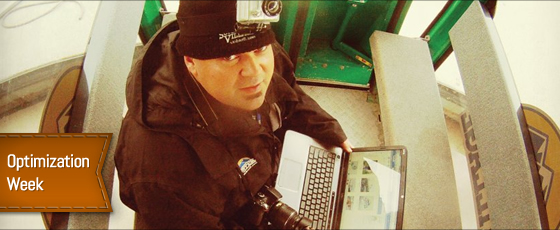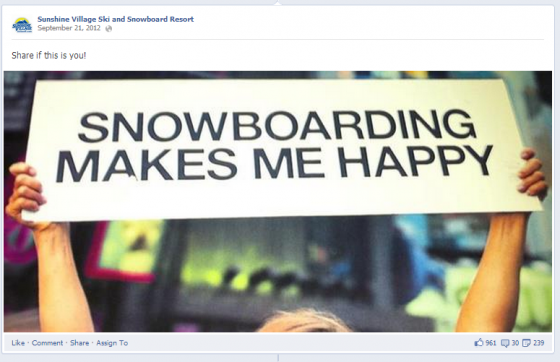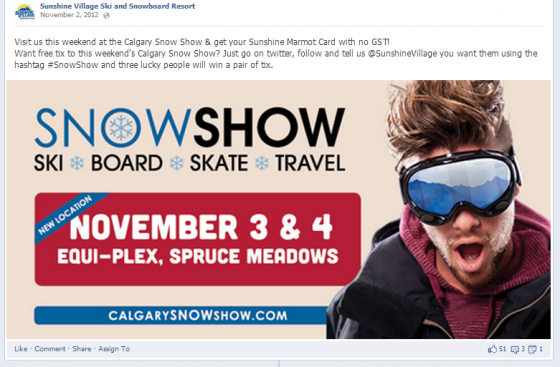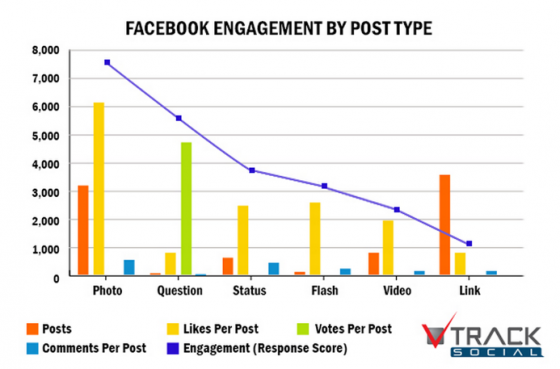Optimization
The EdgeRank Code: One Resort Marketer’s Approach to Optimizing for Facebook


BLANCHARD
Filters are everywhere. They’re on Google, they’re on Facebook, they’re in your email inbox. So this week we’re talking about resort optimization to work with these filters to get your content the most visibility possible.
Two years ago, Sunshine Village was not in a pretty place when it came to social media. After a massive mess and a long list of lessons learned the hard way, the damage was significant. Many of their social profiles had even be scrapped as an angry crowd beat down their virtual doors.
Enter Shawn Alain. Tasked with SSV’s social presence, Shawn came in, rolled up his sleeves, and went to work. After long hours and experiments, he emerged with a fairly unique approach to social media marketing, especially vis-a-vis other resorts.
In emails and discussions he had hinted at his EdgeRank theories and practices, so with Shawn no longer an SSV employee, I wanted to get his take on what he did, why he did it, and how it worked. Here’s what he said.
—
EdgeRank is the algorithm that Facebook uses to determine what articles should be displayed in a user’s News Feed.
Where:
- Ue: is user affinity (engagement between users/pages increases affinity score)
- We: is how the content is weighted (different content types carry different weights)
- De: is a time-based decay parameter (current posts weighted higher than old posts)
So the formula is:
Engagement + Content + Timing/Frequency = The Art of EdgeRank
The higher your EdgeRank is, the more newsfeeds your posts will show up in. According to Facebook, the average organic post is seen by just 14 % of your followers.
Engagement
A few things to remember.
Replies Count
Your replies to your followers count towards your EdgeRank so interact with your followers…and besides, it’s just good social media to respond to your followers anyways.
Ask for It
Ask your followers for engagement – A photo post like “Caption This” or “Like if you wish you were here now”.
Set a Daily Goal
I have a system I developed where a like is worth 1 point, comment is 3 points and share is 5 points. While with Sunshine Village, I set a daily goal to try and reach 500 points a day. This way when you have a Management Directive to post something like a low engagement, but ROI sales post, you should also post something that day that will be high in engagement so your ‘Talking About’ stays high and gets those sales posts more views.
Example: Photo Caption
Snowboarding makes me happy is the type of post that is a high engagement post. Although this post may not showcase the selling points of your resort, what it does is increase your ‘Talking About’. The low engagement, but sales oriented posts like the snow show one below will now reap the benefits of a higher ‘Talking About’ and appear in more followers newsfeeds. Using this combination will give you the best ROI on your Facebook.
Content
Single photos are king as you can see by the graph below from TrackSocial. Although it doesn’t show the effectiveness of photo albums, I would rank them slightly above status updates but not nearly as good as one great photo. You’ll still want to mix it up some but your time is best spent mostly looking for that one killer photo than a couple days of shooting and editing videos.
Timing/Frequency
This is a big one.
Posts per day
Find out when your best posting times and days are, every page is different so you’ll want to find your sweet spot. When I worked for Sunshine Village, their best to worst days were in this order: Wednesday, Tuesday, Monday, Thursday, Sunday, Friday and Saturday. I’d do as little as two posts on the Saturday and as many as five posts on Wednesday and Tuesday.
When to post
You’ll also want to know your best posting times. There are many programs out there that can help you with this, I prefer www.crowdbooster.com which charges a small monthly fee. But remember that those are just guidelines to help you find that sweet spot. You’ll also want to study your best posts each week and analyze what made it good, was it the content or the time it was posted?
Always schedule your posts a minimum of two hours apart, despite what any tools like Crowbooster might say. Your post needs the chance to perform. Don’t use a 3rd party post scheduler to do your Facebook posts. There are conflicting reports that you may be penalized EdgeRank when doing so. For the extra little bit of work it’s better to just manually post.
If you have a really great performing post, then let it marinate for a while by skipping that next posting time slot.
Hashtags
Rumour has it that Facebook will add hashtag stats into their insights real soon so I’m sure it’s only a matter of time until we will be able to see what hashtags are trending, but in the meantime find out what’s trending on Google Plus and Twitter and www.trendsmap.com and then use the relevant ones in your Facebook post.
Not Science, Art
Finally, this is not an exact science but more of an art form. There is the closely guarded, and constantly changing/evolving, Facebook calculation of EdgeRank. But at the same time one thing that will stay the same is the fact that you are communicating with real people, not some calculation on a server in the Facebook Headquarters.
About Gregg & SlopeFillers
I've had more first-time visitors lately, so adding a quick "about" section. I started SlopeFillers in 2010
with the simple goal of sharing great resort marketing strategies. Today I run marketing for resort ecommerce and CRM provider
Inntopia,
my home mountain is the lovely Nordic Valley,
and my favorite marketing campaign remains the Ski Utah TV show that sold me on skiing as a kid in the 90s.
Get the weekly digest.
New stories, ideas, and jobs delivered to your inbox every Friday morning.



